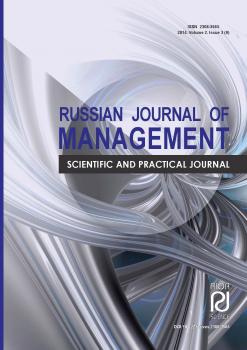Penza, Penza, Russian Federation
The authors studied various theoretical and methodological approaches to the problem of innovation system management and shaping of innovation policy. Essential features of these specific approaches and their weaknesses were allocated. It is concluded that in the practice of public administration it is expedient combination of the various approaches for realizing the full potential of public administration and management to build an innovation economy. The necessity of consistent and concerted macroeconomic and innovation policy established. The innovation policies should be designed taking into account the patterns of long-term economic growth, the global trends of innovative development of the economy as well as available competitive advantages of each country and every region.
innovation system, management, methodological approach, innovation policy
Введение
Инновационный тип развития экономики априори подразумевает переход к интенсивному развитию в противовес экстенсивному пути, по которому по-прежнему продолжает движение наша страна. Благосостояние населения практически полностью зависит от возможностей присвоения природной ренты. Смена самой парадигмы экономического развития требует максимального использования инновационного потенциала экономических агентов, обусловливающего, в конечном счете, инновационную эффективность всей экономики. Новая парадигма экономического развития породила и новые подходы к проблеме государственного управления. Американский экономист-неокейнсианец Д.Ю. Стиглиц обосновал недееспособность классической рыночной теории «невидимой руки рынка» А. Смита, которая, как полагает автор, никогда не была регулятором экономики [9]. Ситуация осложняется нарастающим и намеренно продлеваемым развитыми странами военно-политическим конфликтом, оказывающим существенное негативное влияние на непростую экономическую ситуацию в России. Таким образом, насущной необходимостью становится переход от неолиберализма, тормозящего инновационное развитие, к действенной государственной поддержке и регулированию, обеспечивающим возникновение крупных наукоемких фирм, завоевывающих лидирующие позиции на мировых рынках [1, с. 44].
1. Chernetsov V.I., Gamidullayeva L.A. Modernization of the economy as an imperative of innovative development of Russia. Ekonomika i upravleniye [Economics and Management], 2014, no. 1 (99), p. 45-52.
2. Glazyev S.Yu. Teoriya dolgosrochnogo tekhniko-ekonomicheskogo razvitiya [Theory of long-term technical and economic development]. Moscow, VlaDar Publ., 1993. 310 p.
3. Gokhberg L. Natsionalnaya innovatsionnaya sistema. Voprosy ekonomiki [Problems of Economics], 2003, no 3, pp. 26-44.
4. Granberg A.G., Valentey S.D. Dvizheniye regionov Rossii k innovatsionnoy ekonomike [Movement of Russian Regions Innovative Economy]. Moscow, Nauka Publ., 2006. 402 p.
5. Zhikharev K.L. Metodologiya upravleniya razvitiyem regionalnoy innovatsionnoy sistemy [Management methodology of development of the regional innovation system]: Doct. Dis. Moscow, 2011. 438 p.
6. Ivanova N. Innovatsionnaya sistema Rossii v globalnom kontekste [Innovative system of Russia in the global context]. World Economy and International Relations, 2005, no. 7, pp. 32-53.
7. Makarov V.L. Ekonomika znany: uroki dlya Rossii [Knowledge Economy: Lessons for Russia]. Bulletin of Russian Academy of Sciences, 2003, no 5, pp. 450-456.
8. Postalyuk M.P. Innovatsionnye otnosheniya v ekonomicheskoy sisteme: teoretiko-metodologichesky aspect [Innovative relations in the economic system: theoretical and methodological aspect]: Doct. Dis. Kazan, 2006. 339 p.
9. Stiglitz J. Information and the change in the paradigm of economic theory. Ekovest, 2003, no 3. URL: www.research.by/webroot/delivery/ files/ecowest/2003n3r01html.pdf.
10. Tatarkin A.I. Construction of the innovation system as a condition for providing the technological modernization of the economy. Innovatsii [Innovations], 2005, no 3. URL: http:// www.mag.innov.ru.
11. Aydalot P. Milieux Innovateurs en Europe. Economica, Paris, 1986.
12. Bellini N. Real services a re-appraisal. European Planning Studies, 2000, vol. 8(6), p. 711-728
13. Braczyk H., Cooke P., Heidenreich M. (eds) Regional Innovation Systems. London: UCL Press, 1998. P. 286-318.
14. Carlsson, В., Jacobsson, S., Holmen, M. & Rickne, A. Innovation Systems: Analytical and Methodological Issue. Research Policy, 2002, vol. 31 , p. 233-45
15. David E.A. Clion and the Economics of QWERTY. American Economic Review, 1985, no 75, p. 332-337.
16. Edquist C. Systems of Innovation: Technologies, Institutions and Organization. Cassel, London, 1997.
17. Feldman M.P. The geography of Innovation. Kluwer Academic Press, Boston, 1994.
18. Freeman C. The National System of Innovation in Historical Perspective. Cambridge Journal of Economics, 1995, no 19, p. 5-24
19. Grossman G., Helpman E. Innovation and growth in the global economy. London. Cambridge (MA), 1992. 16 p.
20. Laranjaa M., Uyarrab E., Flanaganb K. Policies for science, technology and innovation: Translating rationales into regional policies in a multi-level setting. Research Policy, 2008, no 37, р. 823-835
21. Lundvall, BA. Systems of Innovation: Growth, Competitiveness and Employment, An Elgar Reference Collection. Cheltenham: Edward Elgar Publishing, Cheltenham, UK, 2000.
22. Maillat P. Territorial dynamic, innovative milieus and regional policy. Entrepreneurship and regional development, 1995, no. 17. pp. 157-165
23. Martin R., Sunley P. Path dependence and regional economic evolution. Journal of Economic Geography, 2006, no. 6 (4), pp. 395-437
24. Metcalfe S., Gibbons M. Technology, Variety and Organization . Research on Technological Innovations - Management and Policy, 1989, no. 4, pp. 153 - 193.
25. Nelson R. National Innovation Systems: A Comparative Analysis, New York. Oxford University Press, 1993. 541 р. DOI: 1016/s0737-6782(95)90054-3
26. Nelson R.R., Winter S. G. An evolutionary theory of economic change, Belknap Press, Cambridge, 1982.
27. OECD. Technical Change and Economic Policy. OECD, 1980. Paris. DOI:https://doi.org/10.1787/eco_surveys-fra-1980-en
28. OECD. Technology and the economy: the key relationships. OECD. Paris, 1992. DOI:https://doi.org/10.1016/0016-3287(92)90127-2.
29. Pyke et al. Industrial districts and inter-firm cooperation in Italy. Geneva International Institute for Labour Studies, 1990.
30. Romer P. The origins of endogenous growth. Journal of Economic Perspectives, 1994, no 8, p. 3-22. DOI: http://dx.doi.org/10.1257/jep.8.1.3
31. Schrer F.M. Firm size, market structure, opportunity and the output of patented inventions. American Economic Review, 1965, no 55 (5), p. 1097-1123
32. Varga A. Local academic knowledge transfers and the concentration of economic activity. Journal of Regional Science, 2000, no 40(2), p. 289-309. DOI:https://doi.org/10.1111/0022-4146.00175.














